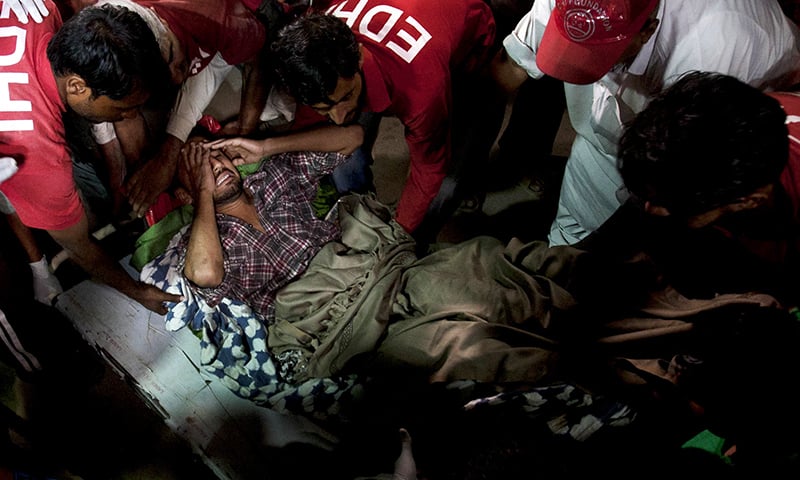At least 52 people were killed and 102 were injured on Saturday evening in a bombing at the shrine of Shah Norani in Khuzdar district of Balochistan, DawnNews reported.
"52 people have died and dozens injured in the incident," confirmed Balochistan Home Minister Mir Sarfaraz Ahmed Bugti.
Bugti also hinted towards foreign involvement in the attack. It was not confirmed whether the bombing was a suicide attack or a remote detonation.
What we know so far
- Blast within the premises of the shrine
- At least 52 killed, 102 people injured
- Difficulty in reaching site of incident due to its remote location
- No major hospital nearby
- 50 ambulances dispatched from Karachi
- Emergency declared in Karachi hospitals
The explosion took place at the spot where the dhamaal (Sufi ritual) was being performed, within the premises of the shrine.
“Every day, around sunset, there is a dhamaal here, and there are large numbers of people who come for this,” said Nawaz Ali, the shrine's custodian.
At the time of the blast, there were at least 500 people gathered at the spot to view the performance, said Abdul Hakim Lasi, a senior Edhi official in Khuzdar district.
The militant Islamic State (IS) group claimed responsibility for the attack, reported Reuters.

Security forces reached the spot of the incident and established a cordon around it. Emergency services faced difficulty in reaching the site of the bombing due to its remote location and poor communication infrastructure.
The shrine is also located in hilly terrain, which further added to the difficulties faced by emergency services.
Electricity services were disrupted following the explosion, hampering rescue efforts further. Electric power to the shrine was supplied with generators, DawnNews reported.
A control room was also established in Quetta to coordinate rescue efforts.
Army teams dispatched
On orders from the Chief of Army Staff General Raheel Sharif, army troops and medical teams were dispatched to the Shah Noorani shrine to provide medical and rescue services to the injured, said a tweet from the Inter-Services Public relations.
Army medical teams treated the wounded at the location.
ISPR also said the route and terrain was difficult, adding to the time to reach the site of the bombing.
Further reinforcements and additional 45 army ambulances were also dispatched to the scene of the bombing, with additional support from Sindh Rangers.
The army's media wing added that helicopter evacuation of the wounded will be attempted, as no airstrip was present nearby to land larger aircraft.
Two army helicopters were sent from Quetta to evacuate the injured.
Lack of medical facilities
Two platoons of the Frontier Corps reached the shrine with medical and rescue equipment, and were one of the first teams to initiate rescue operations.
No major hospital is located near the shrine, reportedly the injured were being shifted in private vehicles.

An emergency was also declared in hospitals of Khuzdar and Karachi. The only hospital in the district is Civil Hospital Khuzdar, which was not equipped to handle the scope of the emergency.
On instructions of Sindh Chief Minister Murad Ali Shah, around 50 ambulances were dispatched from Karachi to the Shah Noorani shrine. He also condemned the attack and expressed grief over the lives lost.
The injured began to arrive in Karachi hospitals hours after the bombing took place.
"At least 12 bodies have been brought to the hospital,” a medico-legal officer, Dr. Abdul Ghaffar Shaikh told Dawn.
The medico-legal officer said that around 20 to 26 injured were brought for treatment to the hospital. The hospital administration also issued a list of the casualties.
“People who are critically injured in the blast will be transported to Karachi," said the home minister of the province soon after the bombing.
President of National Party Mir Hasil Bizenjo earlier said the death toll can increase if the federal or Sindh government do not provide helicopters for evacuating the injured.
"There are no helicopters available with the provincial government to evacuate the injured," confirmed Anwar Kakar, a spokesperson for the Balochistan government.
While answering a question regarding security measures in Balochistan, the home minister had said “If there is security lapse on part of the state, those responsible will be held accountable".
President Mamnoon Hussain and Prime Minister Nawaz Sharif strongly condemned the bombing in separate statements.
Following the attack on the Shah Noorani shrine, security was tightened across major Sufi shrines in the country.
The shrine is frequented by a large number of devotees on Friday, and is visited by people from across the country. Iranian nationals also frequent the shrine. It is approximately 150 kilometres from Karachi.
Earlier attacks
In October, heavily-armed militants wearing suicide vests stormed a police academy in Quetta, killing at least 61 people and wounding at least 117.
Three gunmen burst into the sprawling academy, targeting sleeping quarters home to some 700 recruits, and sent terrified young men aged between 15 and 25 fleeing.
Communication intercepts showed the attack was carried out by Al-Alimi faction of the Lashkar-i-Jhangvi (LJ) militant group.

In August, a suicide bomber targeted the emergency services ward at Quetta’s Civil Hospital killing at least 70 people and leaving scores injured, majority of those killed were lawyers.
Tehreek-i-Taliban Pakistan (TTP) splinter group, Jamaat-ul-Ahrar (JuA), had claimed responsibility for the bombing which occurred at the gates of the building housing the emergency ward.
Balochistan has been experiencing incidents of violence and targeted killings for over a decade. More than 1,400 incidents targeting the minority Shia and Hazara community have taken place in the province during the past 15 years.
The largest province of the country by area, is home to a low-level insurgency by ethnic Baloch separatists. Al Qaeda-linked and sectarian militants also operate in the region. The province shares borders with Afghanistan and Iran.















































